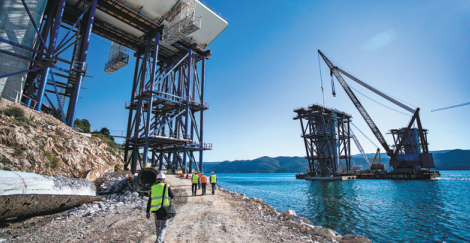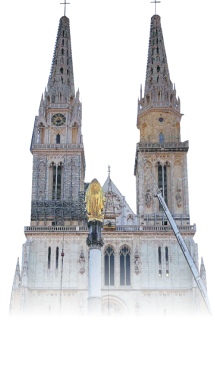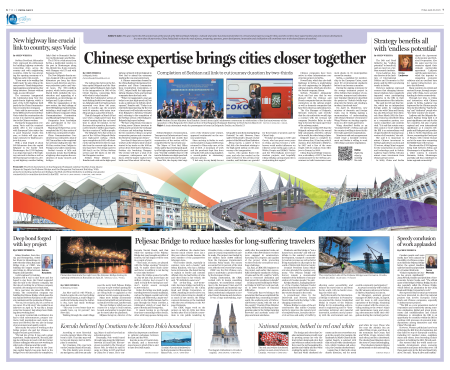
Fireworks illuminate the night over the Peljesac Bridge during its opening ceremony in Komarna on July 26.

The construction site of the Peljesac Bridge near Komarna, Croatia, on Oct 20, 2020.

The Zagreb Cathedral in Croatia's capital.
Jan Skov and his wife Winnie, a Danish couple who own four holiday homes in Komarna, a small village in southern Dalmatia along the Adriatic Sea, have had many bookings since last summer.
"This year is even better than we usually have, up 50 percent," Jan Skov said.
Walking through the small village near the newly built Peljesac Bridge, it is easy to spot workers putting finishing touches to holiday homes that are being built or upgraded as the summer tourist season approaches.
Many more holiday accommodations are being built not just in Komarna but all over the coast, Jan Skov said.
The new bridge is widely seen as a reason for a surge in local tourism, he said, and another is people's hunger for travel after the pandemic.
Miljana Borojevic, director of the Korcula Tourist Board, said that while the opening of the Peljesac Bridge last year brought an influx of tourists, the full impact will be seen in a couple of years.
"The locals, of course, are pleased with the bridge opening," Borojevic said. "It makes travel much easier and faster, in addition to not having to cross state borders."
Since the bridge opened to traffic on July 26 last year, more than 1.33 million vehicles had crossed it by April 17. Daily flow during last summer's tourist season averaged 15,000 vehicles.
Before the bridge was built, people traveling between Croatia's mainland, such as the biggest coastal tourist city of Split, and Dubrovnik, a major tourist city on the Mediterranean, had to pass through the Neum Corridor, a 9-kilometer stretch of coast that is part of Bosnia and Herzegovina.
It meant having to go through four time-consuming border checks, often with long queues during summer. In addition, the checks have become much stricter since Jan 1 this year when Croatia became the 27th member of the passport-free Schengen Area.
"The border checks, especially in summer, were such a hassle," said Selma Knudsen, who has a holiday home in Komarna. She hated having to explain to border and customs officials why she had bottles of wine and other items in her vehicle, she said. "It's definitely easier now."
The 2.4-km-long, 23.6-meter-wide, four-lane bridge was built by a consortium headed by the China Road and Bridge Corporation, or CRBC. Standing 55 meters above sea level with pylons rising to a height of as much as 124 meters, the bridge connects Komarna on the mainland with the town of Brijesta on the Peljesac Peninsula.
The CRBC began work on the project on July 30, 2018, just three months after it led a Chinese consortium to win public tendering by Hrvatske Ceste, a state-owned company in Croatia responsible for public roads. The project was funded by 357 million euros ($390 million) from the European Commission's Cohesion Policy funds. The money accounted for 85 percent of the total cost, with the rest covered by Croatia.
CRBC was the first Chinese company to undertake a project funded by the European Union.
During construction, the CRBC worked with 18 design consulting companies, 45 construction companies in the European Union and 112 global equipment and materials suppliers, environmental protection and other professional companies in Croatia, Poland, Romania and elsewhere.
It was a huge undertaking, especially after the pandemic broke out in 2020, when 800 Chinese workers were engaged in construction. Ensuring the progress and quality of the project while protecting workers from the coronavirus was a huge challenge.
Liu Jiaxi, a CRBC field engineer on the project, said earlier that successfully meeting the standards of China, Croatia and the EU could be "attributed to everyone's dedication and their pursuit for excellence in details".
Croatia started building the Peljesac Bridge in 2007 but work was halted in 2010 because of financial difficulties.
"I feel pride that we belong to the generation that has accomplished this remarkable feat, connecting Croatia's south, the southern parts of Dubrovnik-Neretva County, with the rest of the country," Croatia's Prime Minister Andrej Plenkovic said during an inauguration gala for the bridge featuring fireworks and acrobatic aerial displays and music and dance.
Plenkovic said the bridge is "not a luxury but a necessity" and will contribute to the country's economic development, transport connectivity, tourism revenues as well as better living standards for all people in the south of Dubrovnik-Neretva County.
Croatia's President Zoran Milanovic also attended the opening ceremony. "The Peljesac Bridge will forever remain a monumental reminder of the boldness of one generation of Croatian people," he said.
Kristjan Stanicic, managing director of the Croatian National Tourist Board, described the bridge as a new attraction that would further stimulate tourist demand in the south.
A promotional video by the Dubrovnik and Neretva County Tourist Board calls the bridge "a life-changing connection".
Peljesac Bridge is a state-of-the-art construction that unifies Croatian territory, improves the region's level of competitiveness, increases the level of services and safety of traffic by allowing easier accessibility, and reduces the travel time to and from the far south, with no border crossings, the video said.
Early this month, the International Bridge Conference in Pennsylvania awarded the Gustav Lindenthal Medal in respect of the Peljesac Bridge for its outstanding achievement in engineering and for "demonstrating technical and material innovation, aesthetic merit, harmony with the environment and successful community participation".
An award ceremony will be held at the IBC annual conference in National Harbor, Maryland, on June 12.
Lu Shengwei, assistant general manager of CRBC Croatia, in Zagreb, said his team is still supervising operations of the bridge, remaining in close contact with the owner, providing training to the owner's repair and maintenance team and ensuring subcontractors fulfill their obligations during the warranty period.

